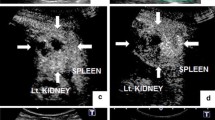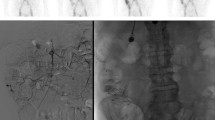Abstract.
Background: Scintigraphic studies of gastrointestinal bleeding are usually performed in static acquisition mode and without continuous imaging over a longer period. The aim of this study was to evaluate the diagnostic accuracy of continuous dynamic 99 mTc red blood cell scintigraphy (BQS) and cine-mode display in the assessment of unexplained gastrointestinal bleeding. Patients and methods: We performed BQS in 40 patients (mean age 57 years) with gastrointestinal bleeding from an undetermined source. All these patients had negative findings of previous examinations. Blood transfusions were required in 16 patients. Continuous dynamic scintigraphic acquisition was performed up to 6 h post injection (p. i.). The scintigraphic data were reviewed without knowledge of the patient's final diagnosis. For this purpose we used a cine-mode display. Results: Dynamic 99 mTc red blood cell scintigraphy correctly identified the site of active bleeding in 22 of 23 patients with positive scintigraphic findings. The sensitivity of the scan was 95 %, the specificity 94 %, the positive and negative predictive values 95 % and 94 %, respectively. Forty-three percent of the scans became positive within 1.5 h and 82 % within 5 h. Positive scans were more likely in patients who required blood transfusions than in patients without transfusion requirement (16 vs 7 patients), and the bleeding site was identified earlier in the former group (mean 2.83 vs 5.28 h p. i.). The scintigraphic identification of the bleeding lesions enabled the performance of a more limited surgical approach in the colon as well as in the distal small intestine, while exact scintigraphic localization was not possible if the bleeding site was located in the proximal small intestine. Discussion: Continuous dynamic 99 mTc red blood cell scintigraphy interpreted by cine-mode display is highly accurate in the identification of a bleeding site. When performed correctly, scintigraphy enables usually segmental resection of these lesions.
Zusammenfassung.
Einleitung: Herkömmliche szintigraphische Techniken bei der Blutungsquellensuche benutzen in der Regel eine statische Akquisition und erfolgen selten kontinuierlich über einen längeren Zeitraum. Ziel der Studie war es, die diagnostische Genauigkeit einer dynamischen und über Stunden kontinuierlichen Blutungsquellenszintigraphie (BQS) mit 99 mTc-markierten autologen Erythrocyten bei der Abklärung ungeklärter gastrointestinaler Blutungen zu evaluieren. Methoden: Wir untersuchten 40 Patienten (mittleres Alter: 57 Jahre) mit trotz ausführlicher Diagnostik unklarer gastrointestinaler Blutung. Transfusionspflichtig waren 16 Patienten. Die Akquisition erfolgte dynamisch und kontinuierlich bis zu 6 Std p. i. . Die Auswertung erfolgte in Unkenntnis der endgültigen Diagnose unter Verwendung einer cinematographischen Darstellung. Ergebnisse: Die dynamische BQS war bei 23 Patienten positiv und identifizierte bei 22 Patienten korrekt den Ausgangsort der Blutung. Die Sensitivität und Spezifität der Szintigraphie betrug 95 % und 94 %, der positive und negative prädiktive Wert lag bei 95 % und 94 %. 43 % der Szintigraphien wurden innerhalb von 1,5 Std und 82 % innerhalb von 5 Std positiv. Transfusionspflichtige Patienten zeigten im Vergleich mit nichttransfusionspflichtigen Patienten häufiger (16 vs 7 Patienten) und früher (im Mittel 2,83 vs 5,28 Std p. i.) einen positiven Befund. Die szintigraphische Blutungslokalisation ermöglichte sowohl im Dick- als auch im distalen Dünndarmbereich ein limitiertes und befundadaptiertes chirurgisches Vorgehen. Bei einer proximalen Dünndarmblutung war die exakte Lokalisation der Blutungsquelle szintigraphisch hingegen nicht möglich. Schlußfolgerungen: Die BQS mit 99 mTc-markierten autologen Erythrocyten, die über einen ausreichend langen Zeitraum erfolgt, und eine Befundung im Cine-mode-Verfahren weisen eine hohe diagnostische Richtigkeit bei der Abklärung einer unklaren gastrointestinalen Blutung auf. Die Szintigraphie ermöglicht durch eine hinreichend genaue Lokalisationsangabe ein selektiveres und sicheres therapeutisches Vorgehen.
Similar content being viewed by others
Author information
Authors and Affiliations
Rights and permissions
About this article
Cite this article
Meller, J., Schönborn, E., Conrad, M. et al. Verbesserter Nachweis gastrointestinaler Blutungsquellen mit 99 mTc-markierten autologen Erythrocyten und kontinuierlicher dynamischer Szintigraphie mit Cine-mode-Befundung. Chirurg 71, 292–299 (2000). https://doi.org/10.1007/s001040050048
Issue Date:
DOI: https://doi.org/10.1007/s001040050048




